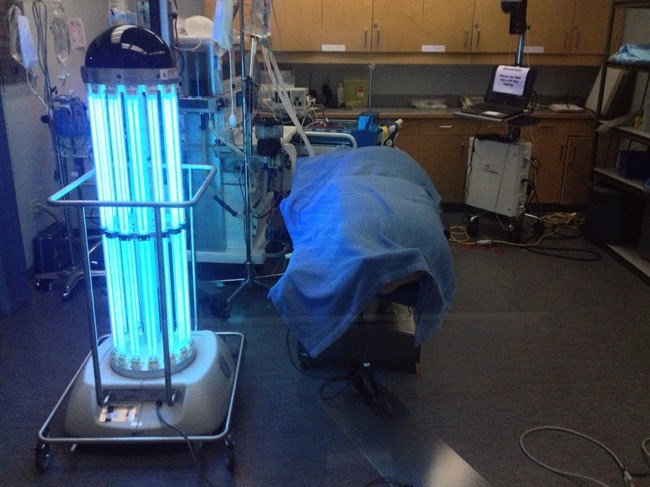VANCOUVER - When Trudi the robot is plugged in and armed, it sounds more like a space shuttle launch system than a germ-killing machine.
"Disinfecting will commence in 15 seconds; please leave the room," Trudi — as staff at Vancouver General Hospital have named it — calls out in a digital monotone from inside a treatment room.
"Disinfecting process started," it continues, as its thin, vertical bulbs blast out powerful ultraviolet rays, killing germs and viruses that might be lurking nearby.
The hospital is the first facility in Canada to use Trudi — whose formal name is Tru-D SmartUVC — as health officials across the country look for ways to protect vulnerable patients from catching potentially deadly bugs such as norovirus and C. difficile.
Health officials in British Columbia have started a pilot project that will see Tru-D and a similar device each tested for five months to determine whether the technology should be used permanently in health-care facilities in the province.
"We've been very impressed with the almost complete eradication of organisms, even when we take it to high concentrations," Dr. Elizabeth Bryce, the medical director for infection control at Vancouver Coastal Health, said after a demonstration of the device on Friday.
"We hope it will decrease the rates of hospital-acquired organisms like superbugs."
The Tru-D device is 1.65 metres tall with long bulbs running vertically up a round, clear shaft — think R2-D2 from "Star Wars" instead of Rosie from "The Jetsons." It can't move on its own and must be manually wheeled from room to room.
A large sensor on the top of the device measures reflections from the UV light to determine the size of the room and how much exposure will be required to disinfect it. The process can take anywhere from 15 minutes to an hour.
It must be used in an empty room that has already been cleaned by hospital staff, said Bryce, providing an extra layer of disinfection rather than replacing existing cleaning.
The five-month pilot project started in January. When that trial is finished, another UV disinfection device, PulseRx, will also be tested.
The results will determine whether the provincial government commits to permanently using either of the devices, which can cost up to $100,000 apiece.
Bryce said the hospital has actually been using Tru-D for the past three months. It asked the company for its test model early as it dealt with the recent norovirus outbreak late last year.
"We did use it in the norovirus season as an add-on to the cleaning, and we're very pleased with that, as well," she said.
The Vancouver General Hospital was among many hospitals across Canada to be hit with a norovirus outbreak in recent months, with infection rates several times higher than average in some places.
The B.C. Centre for Disease Control announced in early January that a busier-than-normal norovirus season was being complicated by the discovery of a new strain of the illness.
Health officials issued their usual cautions that anyone with norovirus should stay away from hospitals to avoid spreading it to other patients.
Tru-D is already being used in the United States and elsewhere, and Bryce said preliminary results from those jurisdiction is encouraging.
She noted hospitals already use UV light to sterilize medical equipment, so using the technology to disinfect entire rooms isn't a stretch.
"UV is not new as a disinfection technology, but it's new in being applied to cleaning patient rooms," she said.

